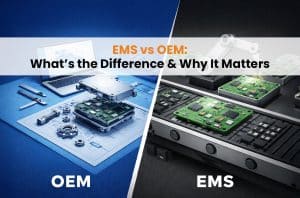As vehicles become more advanced, the integration of electronics has drastically increased. One of the most critical components in automotive electronics is the PCB assembly, which is at the core of numerous systems that enhance vehicle performance, safety, and user experience. From Engine Control Units (ECU) to Battery Management Systems (BMS), electronics manufacturing services (EMS) have revolutionized the automotive industry.
1. Electronic Control Unit (ECU)
Role of PCB Assembly: In the ECU, PCB assemblies integrate microprocessors, sensors, and actuators, enabling the control of crucial vehicle functions like engine performance and transmission. By automating and optimizing these operations, PCBs ensure seamless real-time communication between various vehicle components.
Application in Vehicle: The ECU acts as the vehicle’s brain, controlling subsystems such as engine management, transmission, and braking. With a high-quality PCB for automotives, the ECU processes inputs from sensors and delivers commands to actuators.
User Benefits:
- 1.Enhanced vehicle performance
- 2.Improved fuel efficiency
- 3.Real-time diagnostics and fault detection, reducing repair costs
2. Anti-lock Braking System (ABS)
Role of PCB Assembly: In the ABS, the PCB assembly processes data from wheel speed sensors, adjusting braking force distribution in real time. The microcontrollers on the PCB ensure the system reacts instantly to prevent wheel lock.
Application in Vehicle: ABS systems maintain traction and steering control during sudden braking or on slippery roads. A robust PCB for automotives enables smooth system functioning, improving safety and control.
User Benefits:
- 1.Enhanced vehicle safety, especially in wet conditions
- 2.Shorter braking distances
- 3.Better control during emergency stops
3. Airbag Control Module
Role of PCB Assembly: The PCB assembly in the airbag control module processes impact sensor data and triggers airbag deployment within milliseconds after a collision. Reliable electronics manufacturing services ensure the PCB performs optimally during such critical moments.
Application in Vehicle: Airbag control modules manage the deployment of airbags at the right moment during accidents, ensuring passengers are protected.
User Benefits:
- 1.Increased occupant safety
- 2.Rapid deployment of airbags reduces injury risk
- 3.Reliability across various conditions
4. Infotainment Systems
Role of PCB Assembly: Infotainment systems rely on PCB assemblies to integrate multimedia, navigation, and communication functions. The PCB for automotives enables seamless operation of various inputs, from touchscreens to radio signals.
Application in Vehicle: Modern infotainment systems offer hands-free communication, navigation, and entertainment, enhancing the overall driving experience.
User Benefits:
- 1.Convenience and entertainment during drives
- 2.Real-time navigation aids in fuel efficiency and travel planning
- 3.Increased passenger satisfaction on long trips
5. Battery Management Systems (BMS)
Role of PCB Assembly: The BMS PCB assembly controls battery charging, discharging, and monitoring cycles. It ensures the battery operates within safe voltage and temperature limits, prolonging battery life.
Application in Vehicle: Especially common in electric vehicles (EVs) and hybrids, the BMS optimizes battery performance and ensures safe energy management, which is crucial for vehicle range and efficiency.
User Benefits:
- 1.Longer battery life
- 2.Increased safety by preventing overheating and overcharging
- 3.Optimized energy usage for lower operational costs
6. Advanced Driver Assistance Systems (ADAS)
Role of PCB Assembly: ADAS uses PCB assemblies to integrate data from sensors, cameras, and radar technologies. These systems assist drivers with tasks like lane-keeping and automatic braking by processing real-time inputs.
Application in Vehicle: ADAS enhances vehicle safety and driver comfort by automating certain driving tasks, reducing the chance of collisions.
User Benefits:
- 1.Increased safety by reducing human error
- 2.Enhanced comfort through automated features
- 3.Reduced risk of accidents, potentially lowering insurance premiums
7. Charging Systems
Role of PCB Assembly: The PCB assembly in vehicle charging systems ensures efficient energy transfer from the external charger to the vehicle’s battery. It regulates voltage and current to prevent overcharging and ensures optimal battery performance.
Application in Vehicle: In electric vehicles, the charging system allows for quick and safe battery recharging. Quality electronics manufacturing services ensure these PCBs for automotives operate effectively.
User Benefits:
- 1.Faster, safer battery charging
- 2.Protection against battery damage
- 3.Efficient energy management, saving time and money
8. Adaptive Cruise Control (ACC)
Role of PCB Assembly: The PCB assembly in ACC systems processes data from sensors and radar to adjust the vehicle’s speed and maintain a safe distance from the car ahead. This system provides real-time decision-making to ensure smooth driving.
Application in Vehicle: ACC automatically adjusts vehicle speed based on traffic conditions, reducing the need for manual intervention during long drives.
User Benefits:
- 1.Reduced driver fatigue
- 2.Enhanced safety by preventing tailgating
- 3.Fuel efficiency through consistent speed regulation
Conclusion
In today’s automotive industry, PCB for automotives plays an indispensable role in ensuring vehicle safety, performance, and efficiency. From ECUs to Battery Management Systems, the impact of electronics manufacturing services on vehicle automation and user comfort is undeniable. The integration of high-quality PCB assemblies continues to push the boundaries of what modern vehicles can achieve, delivering enhanced functionality and safety for drivers and passengers alike.
By relying on advanced EMS electronics, the automotive industry is poised for continued innovation, offering users an experience that is safer, smarter, and more efficient.


